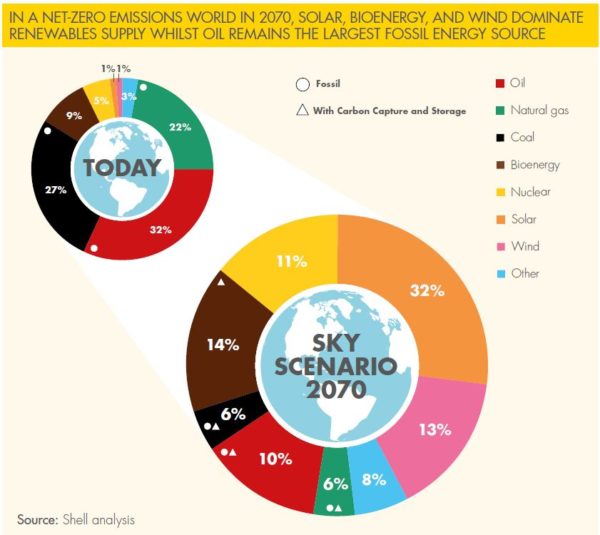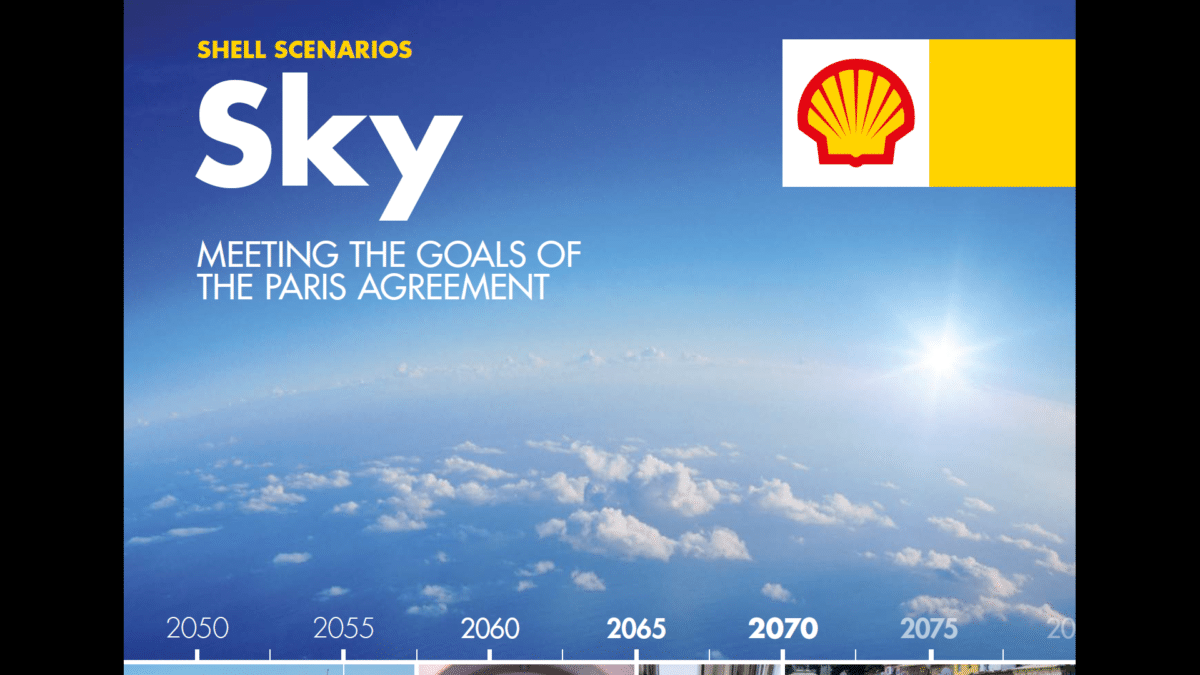Most oil and gas supermajors are not presenting future energy scenarios in line with the Paris Climate Agreement where renewable energy plays a central role. But apparently Shell is not your typical oil and gas supermajor.
Unlike its American counterparts, the Anglo-Dutch company has long acknowledged the reality of global climate change. Furthermore, the company has made significant inroads in renewable energy, including acquiring a 44% stake developer Silicon Ranch, which is active in the U.S. South.
Last week Shell issued a new report, the third in its series of future energy scenarios for the 21st century. Like the previous Mountains and Oceans reports Sky envisions a very strong role for renewable energy, particularly solar, starting well before 2050.
Unlike the other two, Sky models a strong role of policy and markets, looking at a combination of bottom-up and top-down change. But perhaps the biggest differentiator is that Sky envisions a world where temperature increases are limited to below 2 degrees Celsius.
This is all happening in a world where despite increasing efficiency primary energy demand continues to grow, with Shell anticipating a doubling of global primary energy demand from 2000 to 2050, and continuing to grow after that.
Solar and EVs on the rise
In Sky, Shell models solar PV growth rates of 20% annually, with all new incremental electricity demand met by solar and wind by the 2030s. Under this measure, solar will reach 6500 GW of installed capacity by 2035, and from then to 2070, nearly 1000 GW will be added annually, with the global footprint of PV approaching the area of Spain.
This is accompanied by large increases in wind, biomass and other forms of renewable energy, but none on the scale of PV. In fact, the report sees solar meeting roughly the same portion of primary energy demand as oil in 2050, and becoming the dominant source of global primary energy – not just electricity, but all energy – by 2070.

This would be enabled by a massive increase in deployment of electric vehicles (EVs). Sky sees EVs representing more than half of global car sales as early as 2030, and this extending to all passenger vehicles by 2050, due to a combination of technologies including autonomous vehicles and 3D printing.
Contrast with EIA, IEA, and U.S. utilities
Shell’s vision of a future powered largely by solar and other forms of renewable energy contrasts sharply with the scenarios put forth by the International Energy Agency (IEA), U.S. Department of Energy’s Energy Information Administration (EIA) and even more with the plans of U.S. utilities.
Both EIA and IEA are assuming much less dynamic future growth from solar, with IEA predicting that solar deployment will flatten in mid-century. In both cases, a number of academics have prominently criticized the assumptions made by the agencies. It is worth noting that the previous scenarios issued by both agencies missed the growth that renewable energy has seen, and both agencies show a bewildering inability to adapt their forecasts to reality.
But even the willful blindness of EIA and IEA to the growth of renewable energy is surpassed by that of many U.S. utilities. In its most recent forecast Duke Energy predicted that renewable energy would supply only 23% of electricity in its service area by 2050, and Michigan’s DTE Energy has released a renewable energy compliance report which shows that it expects to install only 13 MW-AC of solar through 2022.
But not all players in the power sector are showing the stubborn resistance to change that Duke and DTE display. NextEra Energy, which owns utility Florida Power and Light, recently signed a 2.75 GW PV module deal with JinkoSolar – the largest PV module supply contract known to pv magazine staff to date.
In the end, it remains to be seen if the forecast for solar in Sky plays out. There are several factors that could change everything, such as the potential for accelerated climate change due to natural feedback loops such as methane escaping from permafrost, which could lead to an increasing rate of natural disasters, failures of agriculture and rapid societal change.
In the end there is the possibility that even Shell is underestimating the rate of change, as the most optimistic scenarios have to date.
This content is protected by copyright and may not be reused. If you want to cooperate with us and would like to reuse some of our content, please contact: editors@pv-magazine.com.









Excellent article, except I would say ‘there is the high likelihood’ “that even Shell is underestimating the rate of change”, especially as we know the current pace of change will take 400 years(1) to meet our climate needs. The rapid change needed WILL be possible with innovations like the PV Robotics automated PV installation project created to massively increase the pace of PV deployment while lowering costs even further. The future is VERY bright for PV!
(1) “At this rate, it’s going to take nearly 400 years to transform the energy system”, March 14, 2018, MIT Technology Review, https://www.technologyreview.com/s/610457/at-this-rate-its-going-to-take-nearly-400-years-to-transform-the-energy-system/
I’m sorry, but that MIT Tech Review article that you link to is not credible. Averaging the rate of MW added over the last 15 years ignores the exponential rate of growth. It’s an abuse of statistics.
So while we are going too slowly (agreed on that), 400 years is total hogwash.